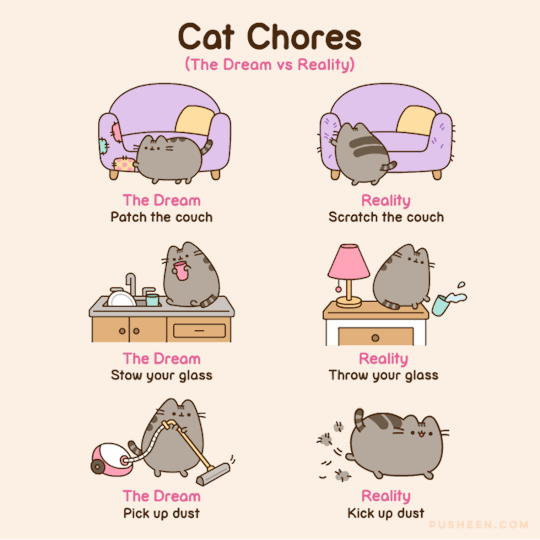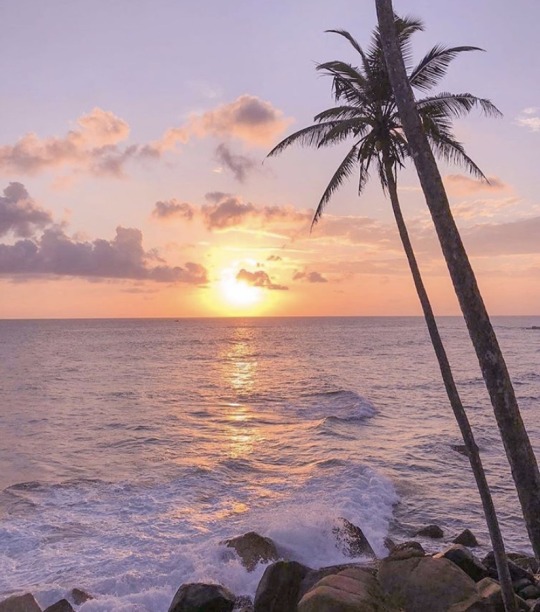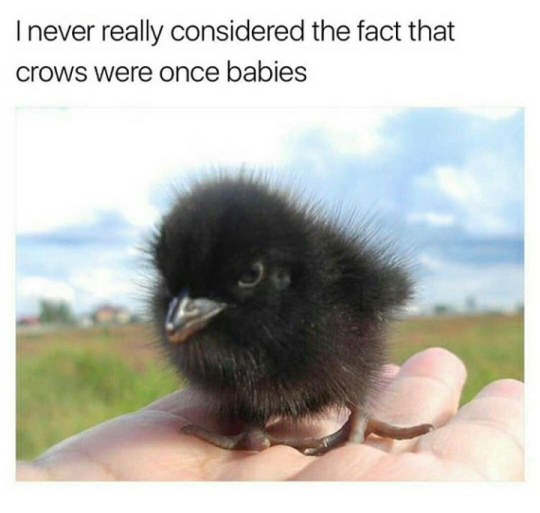Text
Back with another video 🐭 ✨
youtube
0 notes
Text
Tumblr, what's good?
I literally signed on here to check out what's been going on, and it felt like coming home
0 notes
Text
Living Rent Free in My Mind
I have lately decided to make social media in my life take a back seat. For the first time, I'm not preparing for anything school-wise, and my world is work and home. I'll still be posting, but it's something I'll be doing in the back, not something I feel I must do like in the past.
3 notes
·
View notes
Text
Already Gone
I went home recently, and there were moments where I saw my parents and felt as if they were already gone, as if I was seeing their ghost. Have you all seen that scene in Wonder Woman 1984, where the reincarnation of her boyfriend says he's already gone? I guess it really shows how we value people in their personalities.
However, next time I'm at home, I'm just going to live in the moment, and you know, be the best daughter I can be? Yep, that's my year's motto: live moment-to-moment. You just never know what will happen next.
2 notes
·
View notes
Text
No One Cares
Recently, I went home while my housemate was moving out. I didn't want to get in her way. Big mistake.
The week before she left, the handyman came over and needed to remove some clothes in her closet to get access to one of the walls inside it. We called her about it, and she told him to just put the clothes on her bed.
Fast forward a week later, I come home to the house in a total mess. She sent pictures to the landlady saying I left the house messy and put her clothes on her bed in disarray.
I sent the landlady proof it wasn't me, but it reminded me: so many people out here are just out looking for themselves and so many people are fake. I guess it's just a reminder to just brush them off and who to stay away around. The faster I can get over these sort of people, the better.
0 notes
Text
Flippers, not fingers: Sea turtles’ surprising feeding strategies
Imagine you’re trying to eat a snack—a tasty sustainable fish taco, let’s say. But there’s no plate, no cutlery, and you can’t use your hands. Also, gravity is muted, so the taco has a frustrating tendency to float away between bites.
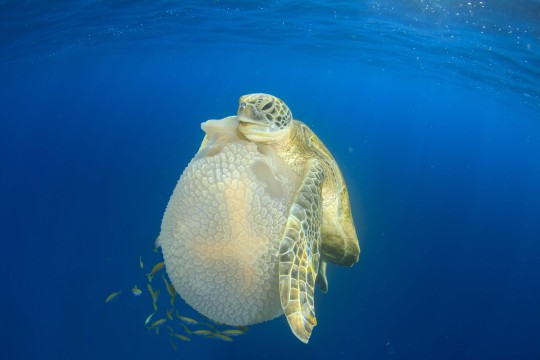
Sea turtles use their flippers in a multitude of ways to help them capture prey, like this green sea turtle in the Gulf of Thailand that’s grasping a jelly before it eats. Photo ©Rich Carey/Shutterstock.com
If this sounds difficult, you’re beginning to understand the challenge of being a hungry sea turtle, stuck with awkward flippers more useful for moving around than for grasping prey.
Still, sea turtles make do with what they have. And, as it turns out, they can (and do) use their forelimbs to corral, swipe and hold food.
Their behavior is the subject of a new publication by Monterey Bay Aquarium researchers Jessica Fujii and Dr. Kyle Van Houtan. It’s something that’s been noted in passing in scientific literature, but Jessica and Kyle say it’s a fascinating glimpse into the evolution of ocean creatures.
To illustrate, Jessica points to a photo of a green sea turtle taken in open water in the Gulf of Thailand. Between its flippers, it’s holding a tasty meal: not a fish taco, but a spherical jellyfish nearly the size of the turtle itself.
Getting a grip on a meal
“In the open ocean environment, there isn’t much to help this sea turtle keep its food in place,” Jessica explains. “So in the picture, he’s using his flippers to keep the meal from drifting away while grabbing pieces with his mouth.”
Hawksbill and loggerhead sea turtles have also been spotted using their flippers to forage. In another image, a loggerhead seems to roll a scallop against the seafloor.
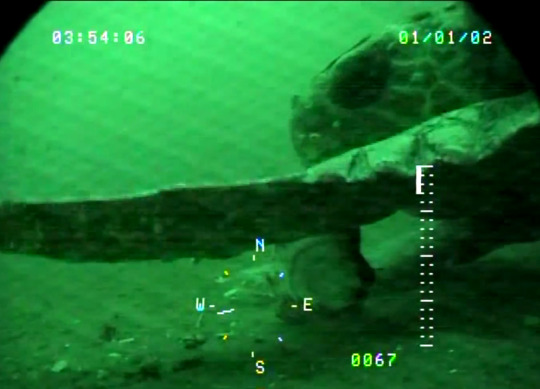
A loggerhead sea turtle leverages a scallop against the seafloor to open its shells before eating the meat inside. Photo courtesy Coonamessett Farm Foundation
“It has to get the two halves of the shell open to get inside,” Jessica says. “It’s using its flipper to push down the shell part, and with its mouth it’s pulling out the meat.”
Jessica is part of the Aquarium’s sea otter research team where she has explored topics in ecomorphology—the nexus of evolution, behavior and body form. She previously co-authored a paper investigating the origins of tool use by sea otters, which use their paws when foraging.
“Sea turtles’ limbs have evolved mostly for locomotion, not for manipulating prey,” she says. “But that they’re doing it anyway suggests that, even if it’s not the most efficient or effective way, it’s better than not using them at all.”
Hardwired evolutionary behavior
Similar behaviors have been documented in marine mammals from walruses to seals to manatees. But sea turtles are far more ancient, appearing in the fossil record around 100 million years earlier.
Kyle, who directs the Aquarium’s science program, says seeing this behavior in turtles was a surprise—one that raises questions about which traits are learned and which are hardwired.

Researchers were surprised to find sea turtles using their flippers in sophisticated ways while feeding — like this one holding onto its prey.
“With a highly intelligent, adaptive social animal, we expect these things to happen,” he says. Otters, for example, have social structures packed with opportunities to watch and learn the subtleties of dexterous foraging.
“With sea turtles, it’s different; they never meet their parents,” Kyle says. “They’re never trained to forage by their mom. It’s amazing that they’re figuring out how to do this without any training, and with flippers that aren’t well adapted for these tasks.”
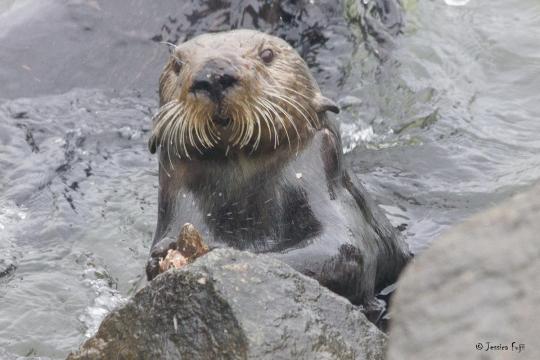
Sea otters use their dexterous paws when foraging, but them must learn the behavior from their mothers. Photo © Jessica Fjuii/Monterey Bay Aquarium
How developmental biology predisposes animals to adopt dining strategies is of particular interest, given the Aquarium’s efforts to raise stranded sea otter pups and prepare them for a return to the wild. Before they’re released, ecologically naïve pups have to be taught foraging behaviors, be it for crabs or abalone, by adult female sea otters at the Aquarium.
“What we’re trying to understand is how to have the best sea otter surrogacy program,” Kyle says. “Sea otters and sea turtles are in some respects at opposite ends of the spectrum. However, learning about one, can help us with the other.”
Hiding in plain sight
For Kyle, inspiration for the flipper study came in 2016 when he was a sober driver for a coral reef conference after-party. While ferrying colleagues back to their hotels in Waikiki, one of his passengers learned of Kyle’s recent paper on hawksbill sea turtles. The passenger mentioned a field research project of his own which involved his team placing sea anemones on a reef in Tahiti. Day after day, the anemones kept disappearing, until the team set out a camera and identified the culprit: a hawksbill turtle.

Foraging sea turtles use their flippers in a variety of ways, In Moorea, this hawksbill turtle braces itself against the coral to feast on a sea anemone.
Based on that chance encounter, Kyle watched the video—and noticed something striking.
“What jumped out at me was as soon as this hawksbill turtle bit an anemone, it put both its flippers on the reef and pushed to get leverage and rip it loose.”
That’s a behavioral trait associated with more evolved groups like mammals, he says—not turtles.
“When you see sea turtles foraging, they eat with their mouths,” Kyle explains. “You see critter-cam footage of a leatherback finding a jelly in its line of sight, swimming toward it, biting it and moving on. A green turtle close to the seafloor, seeing a plant rooted on the bottom—you see them lunging and biting it and moving on. Or a hawksbill that puts its head down in cavities in coral reefs gathering sponges—they’re always using their beak.”
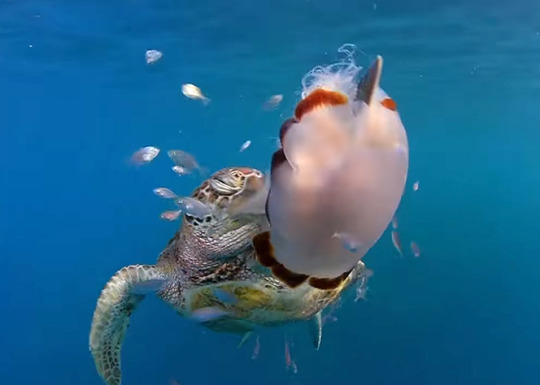
Crowd-sourced photos and videos helped the researchers document the surprising extent to which sea turtles use their flippers when they forage.
Kyle was intrigued. Investigating the phenomenon at scale could’ve been an epic undertaking—hundreds of hours of work, he says—but he and Jessica realized they could effectively crowd-source the footage they were looking for.
“I started Googling and was surprised how many people have captured this behavior,” Jessica says. Thanks to the advent of ubiquitous cameras and massive digital archives like YouTube, a trove of documentation was already available online. “A good number of these videos are just taken by the general public on vacation.”
“I was surprised that even though there are videos showing these behaviors, the topic hadn’t been explored before in this depth,” she says. Then again, the ocean is full of surprises: “I think there’s still a lot we haven’t seen.”
—Daniel Potter
Fujii, J, McLeish, D, Brooks, A, Gaskell, J, Van Houtan, K. (2018) Limb-use by foraging marine turtles, an evolutionary perspective.
2K notes
·
View notes
Text
Summer's Here
For me, this week is a little different than others. Normally, I would go to my summer gig every Tuesday and Thursday, but I don't know, some of my job applications are miraculously progressing. I think, this week, I'd just like to work on some easy job applications, social media, and hanging out with friends here. Next week, I go to my parents' house, and I know my life is going to be house-hunting from then on after I come back. It's really important I spend some time with my family, though, as I don't think I'll be back for a while after.
0 notes
